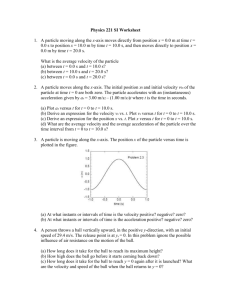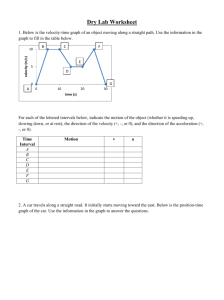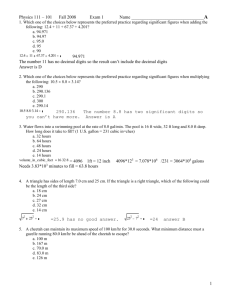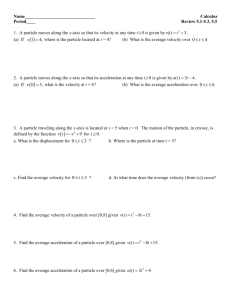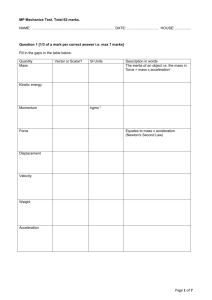File - RYE NECK PHysics & ENGINEER
advertisement
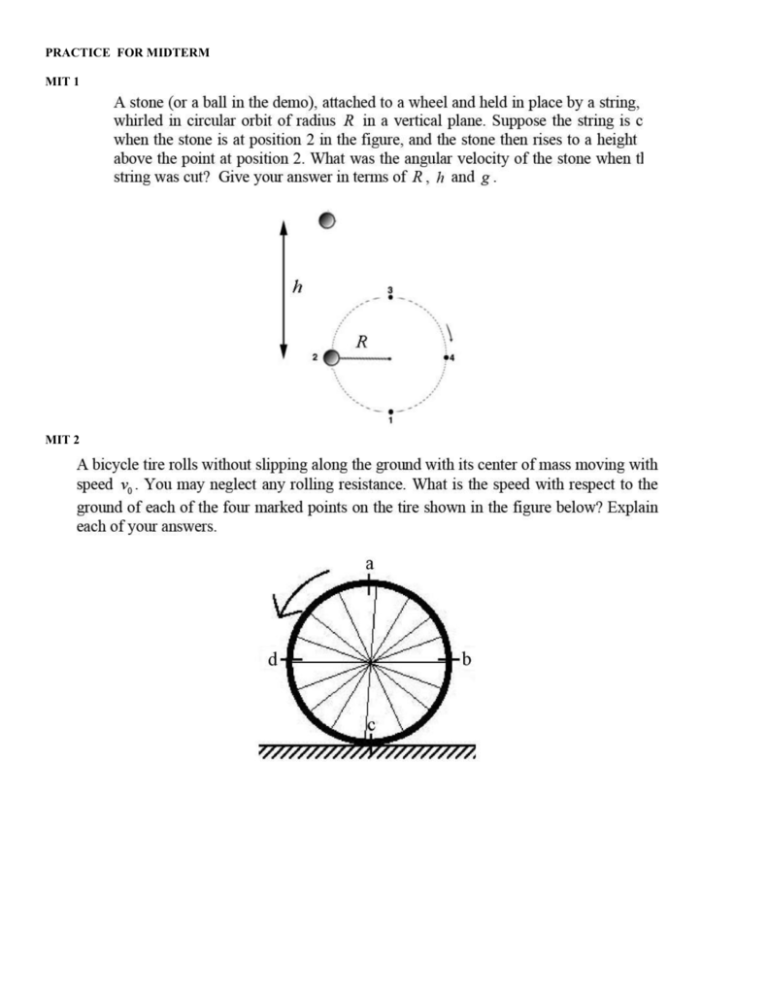
PRACTICE FOR MIDTERM MIT 1 MIT 2 WORKING BACKWARDS PROBLEMS FROM TEXT BOOK PROBLEM 9-68 Page 265 A 20 kg wooden ball hangs from a 2.0 m long wire. The maximum tension the wire can withstand without breaking is 400N. A 1.0 kg projectile traveling horizontally hits and embeds itself in the wood ball. What is the largest speed this projectile can have without causing the cable to break? PROBLEM 9-45 Page 242 Getting a package to the explorer Problem. You can read the full problem in the book, but you are going to use a 1.0 kg rocket that “sticks” a 5.0kg package to the explorer. With what speed does the rocket need to have just before it impacts the package? Think finish first and outline the problem into steps PROBLEM 4-86 An amusement park game, shown below, launches a marble towards a small cup. The marble is placed directly on top of a springloaded wheel and held with a clamp. When released, the wheel spins around clockwise at constant angular acceleration, opening the clamp and releasing the marble after making 11/12 revolution. What angular acceleration is needed for the ball to land in the cup? MIT 4 Draw the FBD for the (a) Painter, (b) the Platform, (c) The painter and platform system MIT 5 HW KNIGHT 1. A wheel initially rotating at 60 rpm experiences the angular acceleration shown below. a. What is the wheel’s angular velocity in rpm, at t=3.0 seconds? (10 points) b. Through how many revolutions has it turned at t=3.0 seconds ? (15 points) 1981 M1 1981M1. A block of mass m, acted on by a force of magnitude F directed horizontally to the right as shown above, slides up an inclined plane that makes an angle with the horizontal. The coefficient of sliding friction between the block and the plane is . a. On the diagram of the block below, draw and label all the forces that act on the block as it slides up the plane. b. c. Develop an expression in terms of m, , F, , and g, for the block’s acceleration up the plane. Develop an expression for the magnitude of the force F that will allow the block to slide up the plane with constant velocity. What relation must and satisfy in order for this solution to be physically meaningful? DRAW FREE BODY DIAGRAM HERE (PART A)! (LABEL ALL FORCES) 1996M2. A 300-kg box rests on a platform attached to a forklift, shown above. Starting from rest at at time = 0, the box is lowered with a downward acceleration of 1.5m/s2 a. Determine the upward force exerted by the horizontal platform on the box as it is lowered. At time t = 0, the forklift also begins to move forward with an acceleration of 2 m/s 2 while lowering the box as described above. The box does not slip or tip over. b. Determine the frictional force on the box. c. Given that the box does not slip, determine the minimum possible coefficient of friction between the box and the platform. d. Determine an equation for the path of the box that expresses y as a function of x (and not of t), assuming that, at time t = 0, the box has a horizontal position x = 0 and a vertical position y = 2 m above the ground, with zero velocity. e. On the axes below sketch the path taken by the box AP MATHY PROBLEMS 1993M2. A car of mass m, initially at rest at time t = 0, is driven to the right, as shown above, along a straight, horizontal road with the engine causing a constant force Fo to be applied. While moving, the car encounters a resistance force equal to -kv, where v is the velocity of the car and k is a positive constant. a. The dot below represents the center of mass of the car. On this figure, draw and label vectors to represent all the forces acting on the car as it moves with a velocity v to the right. b. c. Determine the horizontal acceleration of the car in terms of k, v, Fo, and m. Derive the equation expressing the velocity of the car as a function of time t in terms of k, Fo, and m. 1982M2. A car of mass M moves with an initial speed vo on a straight horizontal road. The car is brought to rest by braking in such a way that the speed of the car is given as a function of time t by v = (v o² - Rt/M)½ a. Determine the time it takes to bring the car to a complete stop. b. Develop an equation for the acceleration of the car as a function of time t. c. On the axes below, sketch the magnitude of the braking force as a function of time t. 2013M2 2010M3 1 2 x shown above. 2 a. Suppose the particle moves so that the x-component of its velocity has the constant value vx = C; that is, x = Ct i. On the diagram above, indicate the directions of the particle's velocity vector v and acceleration vector a at point R, and label each vector. ii. Determine the y-component of the particle's velocity as a function of x. iii. Determine the y-component of the particle's acceleration. b. Suppose, instead, that the particle moves along the same parabola with a velocity whose x-component is given by vx = C/(1+x²)½ i. Show that the particle's speed is constant in this case. ii. On the diagram below, indicate the directions of the particle's velocity vector v and acceleration vector a at point S, and label each vector. State the reasons for your choices. 1983M1. A particle moves along the parabola with equation y = 2010M1 2008M1. A skier of mass M is skiing down a frictionless hill that makes an angle with the horizontal, as shown in the diagram. The skier starts from rest at time t = 0 and is subject to a velocity-dependent drag force due to air resistance of the form F= bv, where vis the velocity of the skier and b is a positive constant. Express all algebraic answers in terms of M, b, , and fundamental constants. . (a) On the dot below that represents the skier, draw a free-body diagram indicating and labeling all of the forces that act on the skier while the skier descends the hill. . (b) Write a differential equation that can be used to solve for the velocity of the skier as a function of time. . (c) Determine an expression for the terminal velocity uT of the skier. . (d) Solve the differential equation in part (b) to determine the velocity of the skier as a function of time, showing all your steps. 2013M1 MIT 6 Sally swings a ball of mass in a circle of radius R in a vertical plane by means of a massless string. The speed of the ball is constant and it makes one revolution every t0 seconds. a. Find an expression for the radial component of the tension in the string as a function of the angle the ball makes with the vertical. Express your answers in terms of some combination of the parameters m,R, t0, and g, the gravitational field strength near the surface of the Earth. b. Is there a range of t0 for which this type of circular motion cannot be maintained? If so, what is that range?




